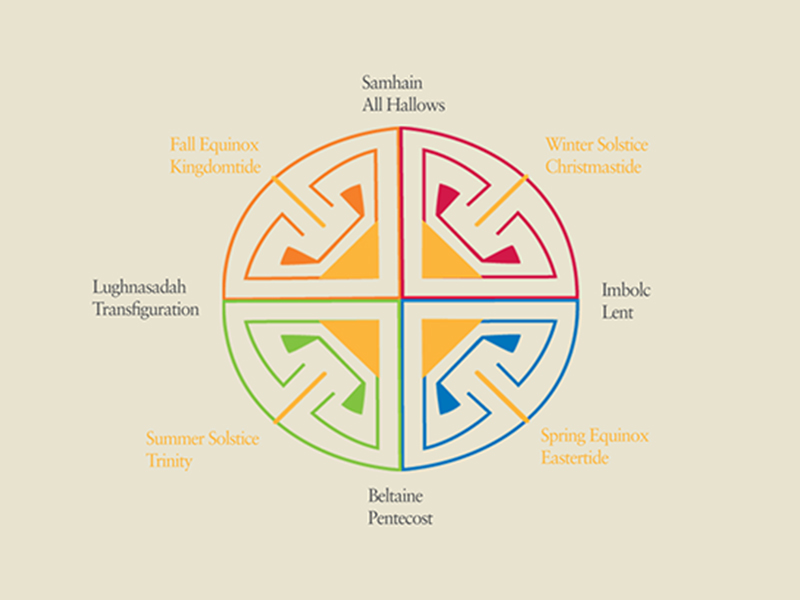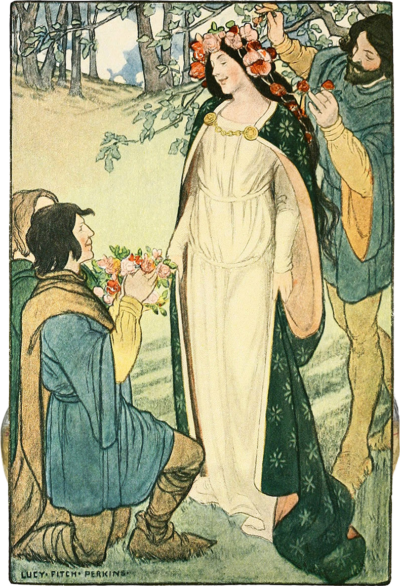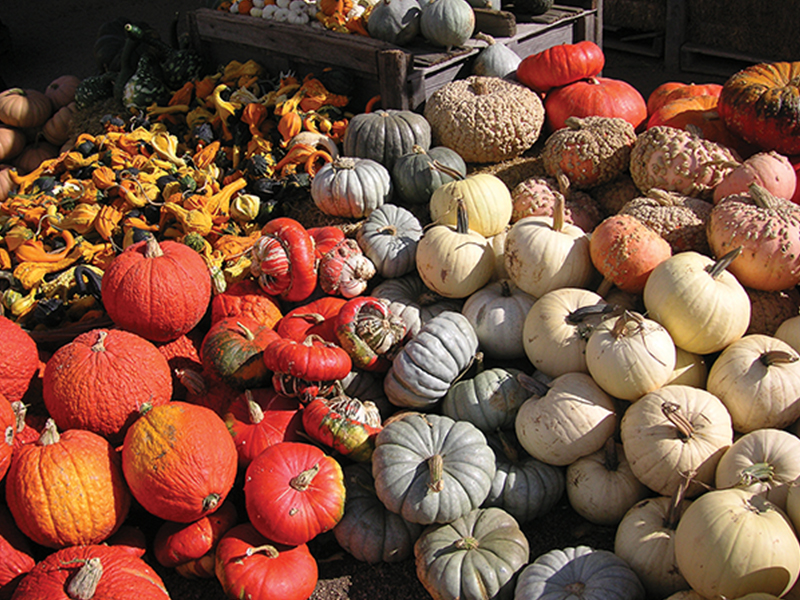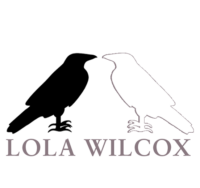I agreed to explore the Archetype of Hunter this year. I admire you who are bravely hunting in yourselves for some connection or at least understanding of the archetype and appreciate the rich and varied comments.
Beltane brings us Robin Hood/Lady Marion (another Pair of Hunters) that are the leaders of a Group of Hunters. It’s as a Group of Hunters that their story celebrates a Community of Resistance versus a Hierarchy of the Aristocracy. This is a subtext I find relevant to explore right now.
We remember Beltane (May Day) is a cross-quarter day falling equally between Spring Equinox and Summer Solstice. A fire festival marking in linear time the beginning of summer, the people of European countries joyfully celebrate this time together as community.

We celebrate the Matron and Patron of Summer (The Ma-ray and the Green Man, Robin and Marion, Pan). Previous blogs generated comments and stories about how many of you celebrate/ed May Day.
- Bonfires and dances
- Maypole
- Traditional Song Summer is Icumen In
- Mary the Mother and Jesus, Patron of the Greening Earth
This year we return to Robin Hood and his group of Hunters, and the May Queen, Lady Marion.
A May Queen is the representation of fertility of the earth. Her many names include the Faery Queen, Flora/Floralia, Eostar/Ostara, Maid Marion. With the coming of Christianity, Mary the Mother of Jesus is given May 1st. As a May Queen her fertility birthed the bearer of the new dispensation of Grace.
The May Queen tradition connecting directly to Robin Hood (the Green Man) and Lady Marion (May Queen) has many time-honored activities, including:
- Robin Hood’s tribute: Some traditions depict Robin’s band gathering flowers for Marion as May Queen
- May Pole Dances
- Robin Hood Games/May Games
- Wild hare races: Some May Day celebrations included capturing or racing hares
- Role-playing: Villagers would dress as Robin, Marion, Friar Tuck and others
- Mock hunts: Staged hunts in the village green recreated Robin’s forest adventures
- Community feasting: Shared meals echoed Robin’s egalitarian distribution of resources
Plays are performed as part of the community celebrations.
The Robin Hood/Lady Marion play available on my website is suitable for seniors to children: the whole community.

Hunting Grounds
Right ownership of Sherwood Forest (Nottingham, England) is a foundation for the Robin Hood/Lady Marion story. The Green Wood (forest) traditionally is a Commons, managed by the communities around it, supported by local controls and customs established in pre-history.
Robin’s band uses various traditional hunting techniques like bow hunting, trapping, and falconry. They track the game and process it. Tanning hides, and preserving meat are communal knowledge reserves.
After the Norman conquest of 1066, William I establishes harsh “Forest Law,” and designates vast territories as royal hunting preserves. In Robin and Marion’s time the forest now belongs to the King. Deer and other game are the property of the noble class, with hunting rights strictly controlled by royal decree. “Commoners” were forbidden to enter the forest for firewood, passage, and particularly to hunt. Punishment for poaching includes blinding, castration, or death for hunting the “King’s deer.”
Hunting for the aristocrats involved “beaters and dogs” who went before the nobles scaring out the game. Fox hunting groups are part of this tradition today.
Community of Resistance
Robin Hood’s band living in the forest, hunting and poaching, is a direct challenge to authority. Robin’s band hunts individually with bows and arrows for subsistence and community welfare, not status. His band is a Community of Resistance against the Hierarchy of the Aristocracy.
External Community Support
The Hunters in the Green Wood (Sherwood Forest) are a cooperative and believe in equitable resource distribution. Their tag line is “steal from the rich, give to the poor.” They rob the hierarchical “nobles” and distribute their hoarded wealth to the communities around the forest. Dressed in green, they go unseen when the Sheriff sends soldiers into the Green Wood to remove them.
The receiving communities surrounding Sherwood Forest provide support and crucial assistance against the oppressive hierarchical structure. They are the distribution network for the meat (protein) and other resources “liberated” from the nobility. Throughout the legends, farmers, millers, and shepherds warn Robin about the Sheriff’s movements. Villagers hide members of Robin’s band when authorities come searching.
System Contrasts
Robin’s band represents a cooperative, community-based approach to hunting and resource management while the aristocracy’s hierarchical model is extractive without regard for results.
Maid Marion is a respected partner in the Green Wood. Her suitors see her as an object desired for her lands and status, and she will be confined/imprisoned in the stories. Robin and the band rescue her, restore her sovereignty.
Robin and his band model shared decision-making and equitable distribution, while the Sheriff embodies the mindset of hierarchy, control, and exploitation.
Robin Hood’s Band teaches us about group hunting communities. Roles are clearly defined for us and are obvious contrasts to the nobility class structure. Each member contributes unique skills that make the group more effective than any individual hunter could be alone.
Group Hunters Community Roles
Leader: Robin is the leader. The band often makes decisions collectively, with each member’s expertise valued. Robin coordinates final decisions about strategy for who they hunt and who receives the distributions. When he is absent, the community makes the decision. The nobles are authoritarian and hierarchical (the King decides and dictates implementation to his chain of command.
Maid Marian (Intelligence/Strategy) – Marian provides crucial intelligence from her connections to nobility. She identifies nobles who might be hunting targets and supplies information about the Sheriff of Nottingham’s movements. She is the band’s May Queen.
Little John (Lieutenant/Strength) – Little John represents physical strength and combat skills, and practical knowledge of hunting operations. He often serves as the muscle when taking down larger game and provides security during hunts.
Friar Tuck (Provisioner/Morale) – Beyond spiritual guidance, Tuck is knowledgeable about edible plants and preservation techniques. He helps prepare and preserve meat and maintains morale through storytelling and companionship.
Will Scarlet (Scout) – Known for his stealth and woodcraft, Will serves as a scout who identifies game movements and reports back to the group before major hunts.
Much the Miller’s Son (Hunter/Trapper) – Skilled at creating traps and snares, Much helps the band capture smaller game efficiently, providing food for the forest band.
Alan-a-Dale (Bard/Minstrel) – Uses bird calls and signals to coordinate group movements during hunts without alerting prey or authorities. The role provides music and entertainment for the band and for the communities who support the band.
Suppression of Communities of Resistance
The connection between Robin Hood, May Day, and social resistance became so strong that May Games and Robin Hood stories and plays were specifically banned by puritan regimes.
Over time May celebrations became a children’s activity, and the stories of Robin and Marion and their communities are designated entertainment. This strategy protected them from being erased.
The Labor Movement has been, is and will be resistance against a hierarchy of owners of the work, and whose goal is wealth not community wellbeing. Some owners long for the robot workers coming online now, who are programmable, need no time off, and will repair and refurbish themselves. Human workers are problems as they hunt for better wages and working conditions. People were and are fired for organizing resistance that reduces owner profit.
May Day evolved into International Workers’ Day and maintains the connection to social justice themes present in the Robin Hood legend.
Groups of Hunters in Times of Chaos
A community is defined as a group of people with a shared characteristic, which might be a place (Sherwood Forest or your neighborhood), a cultural set of norms (a Commons), shared values (equitable distribution of resources). One shared value might be resistance, to refuse to accept or comply with, to attempt to prevent something by action or argument. To resist also means not to be adversely affected by something like a virus, or a strategy of chaotic information.
Chaos behavior is to be so unpredictable as to appear random, owing to great sensitivity to small changes in the environment. With the coming of the computational power of computers we have been able to determine chaos is patterned. Classic examples are the flight of birds and the recognition of fractals. A group of Green Wood hunters might be imaged as a node of a not yet fully distinguishable pattern.
Ilya Prigogine, Nobel Prize-winning chemist:
When a complex system is far from equilibrium,
small islands of coherence in a sea of chaos
have the capacity to shift the entire system to a higher order.
Current Mutual Aid Communities
A long time ago I read an article (no reference decades later, sorry) about elderly folk who lived for many decades in a hilly neighborhood in a major US East Coast city (I think Boston). Children raised and gone, working a job years finished, they saw a future of selling their house, breaking up their relationships, and going to live with family members or in a center. Their revolutionary idea was to go together and fund a couple who served all of them as a community. One person contributed an apartment, others paid for food and necessities, several supported a car. The neighborhood aged in place, with the couple managing cleaning, house repairs, yard maintenance. Eventually the group hired physical therapists and nurse aids. You may know of this or other communities like it and please share your information if so.

My personal experiences with a “Mutual Aid Community” were:
- A small babysitting coop which was organized by cardboard squares with a different color for each member. The agreement was simple: every hour you spent babysitting earned you a colored cardboard square. If a coop member didn’t have any of your colored cards to give back to you they paid cash.
- An organic foods coop that lasted for around a dozen years. You made a giant order once a month, and participated in the once a month division of the bulk products into the individual family bags (4-6 hours). For many years two of us shared responsibility for placing bulk orders for tea, coffee, and spices. Others ordered and divided grains, flours, cheeses, milks, yogurts, boxed and bagged products. Dividing was a 4-hour (average) hardworking joyful party with our kids playing together while we divided. It ended when our children were older and many families had to have both parents working to “make ends meet.”
- Representative Alexandria Ocasio-Cortez developed a Mutual Aid 101 toolkit during the pandemic which includes a poem called “The Low Road” by Marge Piercy: Start your research with the Mutual Aid 101.
Thank you for exploring this first Group of Hunters on this May Day, 2025. Your comments are helpful as expansions and additional/corrective suggestions, enriching this blog. Next time we will continue with the Group Hunter concept but look at Nomadic Hunters—whole communities on the move.
Please take a moment and tell us about your Robin Hood/Lady Marion or Group Hunting experiences.
References
- “Robin Hood: A Mythic Biography” by Stephen Knight – Explores the evolution of the Robin Hood legend, including connections to Green Man mythology
- “The Outlaws of Medieval Legend” by Maurice Keen – A scholarly examination of Robin Hood and other outlaw figures
- “Robin Hood: A Complete Study of the English Outlaw” by Stephen Thomas Knight – Comprehensive analysis of the Robin Hood corpus
- “The Forest Laws and the Death of William Rufus” by Emma Mason – Details medieval forest laws and their social impact
- “Lady Marian and the Green Man” by John Matthews – Discusses pagan elements in the Robin Hood legends
- “The Stations of the Sun: A History of the Ritual Year in Britain” by Ronald Hutton – Contains information about May Day, Green Man traditions, and their connections to Robin Hood
- “Robin Hood: The Many Faces of that Celebrated English Outlaw” by J.C. Holt – A historical perspective on the Robin Hood legend
- “Green Man: The Archetype of Our Oneness with the Earth” by William Anderson – Explores Green Man symbolism in European tradition
- “The Triumph of the Moon: A History of Modern Pagan Witchcraft” by Ronald Hutton – Contains discussions of Marion’s connections with earth goddess figures
- “The Sword in the Stone: Archaeological Excavations at Dinas Emrys” by Leslie Alcock – Some explorations of natural world symbolism in British legend
For information on medieval hunting practices and forest law, these would be valuable sources:
- “Royal Forests of Medieval England” by Charles R. Young
- “The Art of Medieval Hunting: The Hound and the Hawk” by John Cummins
Mutual Aid References:
“How to Create a Mutual Aid Network” article by Mary Zerkel was my source for the Mutual Aid information






Fascinating! I would love to see a film made of the Robin Hood and Maid Marion story. Please let me know if there is one already at the library. Beautiful symbolism.
Lara, yes, there are a number of films and I think a series or two. Check with the librarian and enjoy your exploration!